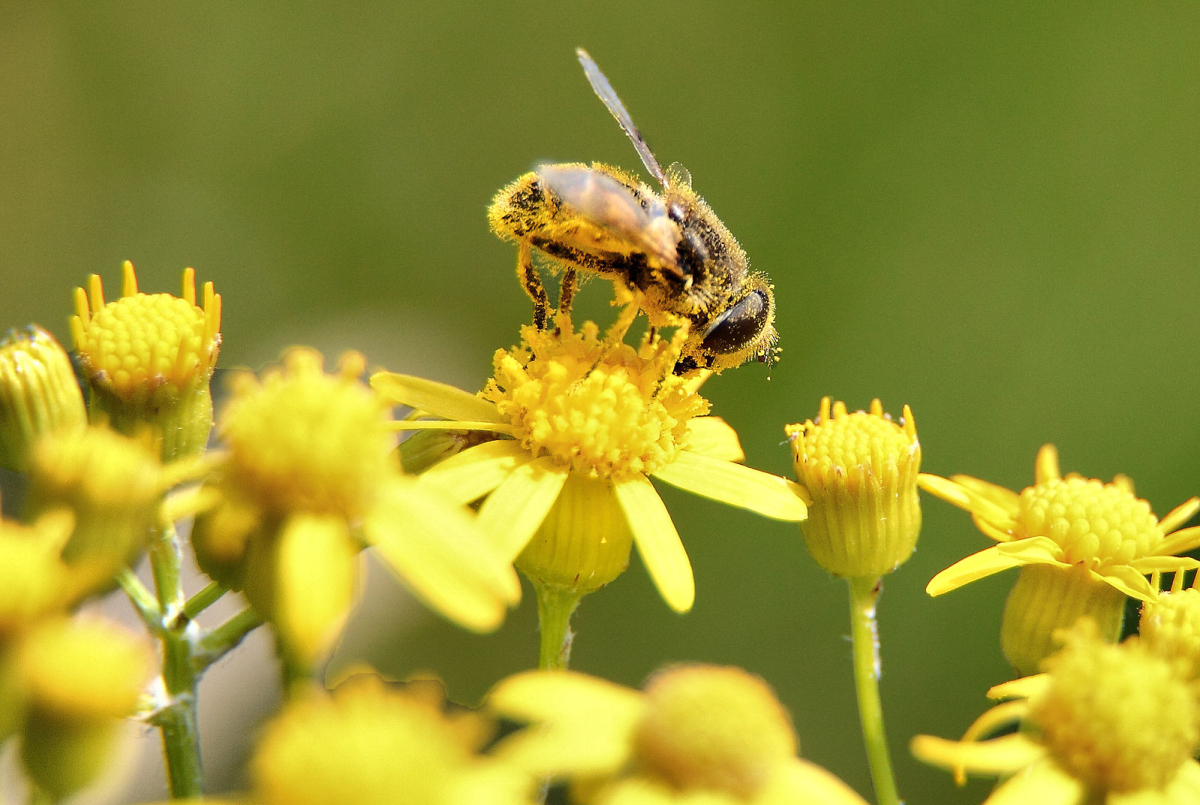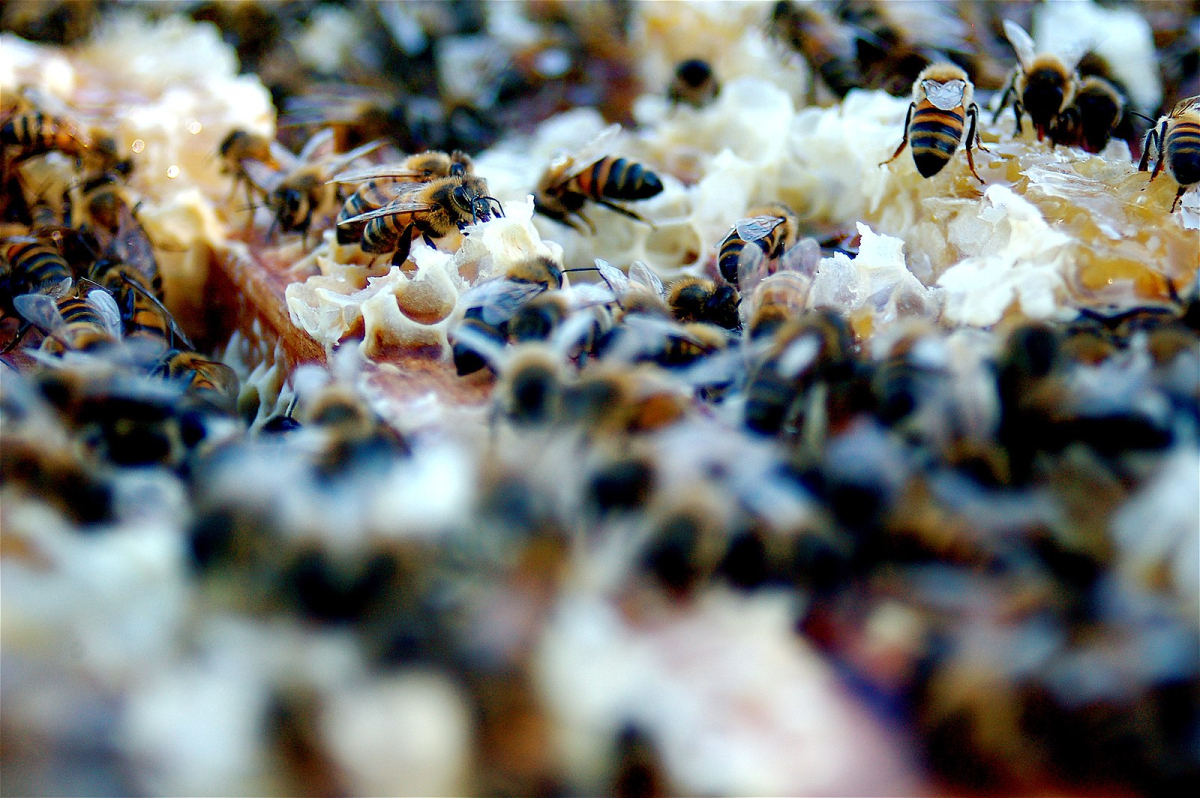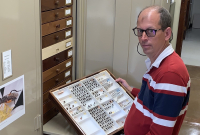Support strong Canadian climate journalism for 2025
The first time Mark Winston entered a buzzing apiary, he fell in love with bees and what their communication skills and co-operation could teach people.
Now, the entomologist and author despairs to see his teachers being silenced in droves.
After years of review, the federal government recently approved the continued use in Canada of three widely used neonicotinoids (or neonics), a common class of pesticides known to harm pollinators like bees and other insects.
There is irrefutable evidence that neonics are harmful to bees — particularly wild bees — and other bugs essential to maintaining healthy ecosystems, said Winston, a professor of apiculture and social insects at Simon Fraser University whose book Bee Time: Lessons from the Hive won a Governor General’s Award.
Yet despite acknowledging the dangers neonics pose in a 2016 proposal to ban them, Canada's recent decision to allow the pesticides continued use is failing to protect bees and other pollinators, Winston and other environmentalists say.
That's left a patchwork of municipalities and provinces trying to pick up the slack. In 2016, Vancouver and Montreal banned neonics within city limits, becoming the first major Canadian cities to do so. Other municipalities and provinces have wide-ranging bans against the use of cosmetic pesticides on lawns and gardens that sometimes include neonics, but not always.
The federal government decides which pesticides can be used in Canada, and sets the thresholds on how much farmers can use and what residual levels can remain on food, explained Louise Hénault-Ethier, director of the Centre Eau Terre Environnement, a research institute within Québec's publicly funded independent scientific research organization. “(But) the provincial governments can be more stringent ... and municipalities can be even stricter.”
Faced with overwhelming evidence the pesticides were harming bees and other insects, Vancouver took advantage of that regulatory leeway, explained Vancouver-Hastings MLA Niki Sharma, who once chaired Vancouver’s park board and was the driving force behind the city's decision.
“(We were) looking at how to support pollinator populations. A big part of that was reducing chemicals that are causing harm (and that) have been scientifically shown to do so,” she said. “There are so many reasons the populations are declining that are part of the human (influence) on nature, but this was one we could just stop doing and really help the populations.”
Montreal's ban had similar origins: In 2015, an international study found severe negative impacts from neonics on pollinators, birds, and other animals. Within months, the city had prohibited the chemicals due to their environmental and health impacts, a spokesperson for the municipal government said in a statement.
Vancouver's ban was well-received by residents, Sharma said, with most urbanites happy to protect pollinators. Many were also comforted knowing the toxic chemicals wouldn't be used on lawns and in parks where pets or children might play.
The effort was so successful that Sharma hopes other municipalities will follow Vancouver's lead: “It would be great if more cities took that on — I think we have a lot of reasons to support our bee populations,” she said.
However, Hénault-Ethier noted initiatives to ban pesticides rarely take root outside urban centres. Farmers tend to be more at ease with chemical use and their attitudes often differ from those of city-dwellers on the issue, she said.
But the federal government faces a political headwind the cities didn't: Lobbying from Canada's $1.7 billion pesticide industry.
Most neonics are used in agriculture that takes place outside of urban centers. Pesticide manufacturers want to make sure they won't lose the lucrative market, explained Hénault-Ethier.
Sharma and the City of Montreal spokesperson confirmed neither municipal government was heavily lobbied by the pesticide industry over their bans.
“It seems like pesticide regulation is really driven ... by entrenched interests that profit off the use of these chemicals,” said Lisa Gue, senior researcher and analyst at the David Suzuki Foundation. “In the case of neonics, we know the final decisions (on whether to ban them or not) were delayed while industry stakeholders assembled additional data for consideration.”
Most of the data submitted is considered confidential business information and can't be independently reviewed, Hénault-Ethier said.
In 2005, neonics accounted for between 11 per cent and 15 per cent of Canada's total insecticide market, according to a 2015 report by Ontario Public Health. A 2018 Health Canada report noted two of the chemicals — thiamethoxam and imidacloprid — are among the top 10 pesticides sold in Canada and are used primarily for agriculture.

Pesticides in Canada are regulated by the Pest Management Regulatory Agency (PMRA), a government body managed by Health Canada. The agency has always been under intense industry pressure not to decrease potential pesticide markets, Hénault-Ethier said.
The PMRA relies on data provided by pesticide manufacturers, or “registrants,” independent researchers or provincial monitoring programs to assess a pesticide's environmental risk and develop mitigation measures, Health Canada confirmed in a statement.
Gue noted the agency has no independent, long-term monitoring system for pesticide contamination in the environment.
Québec implemented strict restrictions on the three main neonics and two other dangerous pesticides in 2018 after finding alarmingly high pesticide levels in the province's rivers and streams.
The province has one of Canada's most extensive freshwater monitoring programs, and regularly tests for pesticides and other contamination, Hénault-Ethier explained. At the time, neonics were appearing in most water samples from the province's agricultural region, and international studies had found that preventative neonics use — a common practice where pesticides are usually applied to seeds before they're even planted — was disproportionately harmful to the environment.
Prior to the new rules, almost all the corn and about half the soy seed planted in Canada was treated with neonics, according to the 2015 report by Ontario Public Health.
Québec's move to significantly restrict the chemicals means that under provincial rules, farmers who want to use neonics must now receive a “prescription” from a professional agronomist — a lengthy and paperwork-heavy process, said Hénault-Ethier.
That is not the case in other regions of Canada. In 2014, Ontario passed a law restricting the use of neonic-treated corn and soy seed, but it was weakened by the Ford government last year. No other province or territory has passed laws restricting the pesticides' agricultural use.
“It's unfair that the rest of Canada does not benefit from the same class of protection as Québec,” Hénault-Ethier said. “It's like we have different classes of society — and Québec citizens' (and ecosystems') health is better protected.”






Comments
Confidential business information? Outrageous. If they want to bring evidence to the government to try to influence an issue of public interest, the public gets to see the information. That should be the law. If they want to keep their business information confidential, they can just keep their oars out of public policy.
On our little Island (about 1,100 souls on about 4,000 ha), there are, commercially, a few apple orchards and a slightly larger number of horticultural (intensive) food crop producers, and a few hundred ha of pasture/ hay-fields. There’s a strong community ethos of environmental protection here, and chemical pesticides are frowned upon. One hay-growing gentleman farmer put ammonia fertilizer on his field and that was enough that certain people would not buy his hay; as far’s I know, he never used pesticides, only used fertilizer occasionally, rotated field crops and pasturage, and ploughed —not rototilled—the soil to maintain fertility without fertilizer as much as possible. He never had any trouble selling his hay. Otherwise, the Island’s exposure to agricultural and horticultural chemicals is very low.
Experience bears this out. We’ve been here over three decades and ran a retail nursery for several years, never stocked any chemical fertilizers or pesticides and in all that while only had one person ever inquire about them—and, once apprised of our custom, he slowly backed toward the swinging doors, keeping his hands in plain sight while apologizing profusely.
There are a hundreds of landscaped residences here and, of course, domestic food gardens. Fruits, vegetables, eggs and flowers are sold from little honour-system stands at the end of laneways all over the Island. The general store stocks local produce and a thriving farmer’s market is open a couple of times a week in summer, once a week most of the year. The hardware store sells gardening tools, seeds and bedding plants. An annual seed exchange and a garden tour which has been going for over two decades attract visitors. This is an Island of gardeners, many retired, who hire out the back-work to young locals (the average age here is 61 years old). Organic growing methods are almost sacred, and Islanders cultivate that reputation as much as they do plants that are good to eat and please the eye.
There’s really only one commercial bee-keeper left. It’s been difficult to survive because of general honeybee decline due to infestations of various species of parasitic mites. Now, introduced giant parasitic hornets are a threat on the horizon. But, even though we don’t have large commercial farms where neonicotinoids are commonly applied, one wonders why some of his bees have perished with tell-tale signs of poisoning by this particular pesticide: the dead worker bees’ tongues are extended out of their mouths during their throes. Since it’s too far to fly across the straits and channels surrounding the Island, it seems the bees must have been poisoned here, on-Island. How is that possible here with so many residences hyper-alert to pesticide use—one might even say ‘overweeningly’ so (nonetheless, most Islanders would justify it whenever our beekeeping neighbour posts another picture of a dead worker bee apparently poisoned with neonicotinoids)?
Two possibilities: many nursery bedding plants purchased at chain retailers in the nearby tri-city hub are treated with neonicotinoids —some labeled so, but probably not all. Presumably bees ingest the pesticide when they visit the flowers to get nectar. The other is persistent use of chemical products specifically marketed to domestic gardeners and sold in boggling diversity at retailers in town—likely applied clandestinely (because of the general opprobrium here) or unwittingly (many newcomers who aren’t yet assimilated into the community have arrived in the past two years).
Many commercial farm chemicals require the farmer or hand successfully pass a pesticide application permit test. It’s not a hard test (it’s open-book right out of the manual). But there are no particular qualifications the home gardener needs before buying some of the bewildering variety of chemical pesticides. The old fella in the giant white runners with the Velcro straps, squinting at the fine print on two competing products in either hand somewhere down the long aisle of pesticides shelved seven feet high is almost an icon—seen especially in spring and early summer.
Likely he already has a variety of half-used pesticide products at home and, if stored in an un-heated garage, might have already lost there labels. Among the cavalier dosing many homeowners rationalize (‘if this much is good, then twice as much should be twice as good,’ for example) is the risk that older purchases might be also misidentified and/or misused, mixed with other products, or unsafely disposed of. Periodically, public health services calls in leftover pesticides, identifiable or not, no questions asked, at special collection events where trained crews separate, identify if possible, an amazing array of rusty metal containers, corroding cardboard boxes, label-less bottles and jars with unknown liquids, bags of rock-hard soil amendments and sweating chemical fertilizers. They always recover a surprising amount of toxic stuff. It is a metric of domestic garden chemical misuse/abuse that’s probably contaminating residential landscaping and gardens. Some research has been done to corroborate this measure with pesticide residues deposited in soil and water, and on food.
Another is measuring the effect of restricting domestic pesticide use—“before-and-after.” Municipalities have been at the forefront of restrictive measures—but usually only on city property, parks, boulevards, &c. Yet these deliberations have been a good way to raise awareness among urban residents, ironically because pesticide industry reps always show up to vigorously argue against any restrictions to their products and that usually swings public opinion against them. Still, it isn’t perfect, it’s still up to individual property owners to decide if they want to eradicate some smut or rust on their roses or help clean up their own environment.
Compared to the two higher jurisdictions, municipalities seem to do the heavy lifting regards pesticide restriction. Whereas federal and provincial lawmakers are obviously reticent to interfere with commercial farmers’ choice of pest control (except to require the chemical be use-tested, registered and regulated through permits)— probably under the most extreme pressure from suppliers of bulk commercial-use pesticides —municipalities may rationalize their interference under the special terms of their charter which demands it levy its own taxes, and not run a deficit: there’s budgetary incentive to reduce pesticide costs city taxpayers have to support. It’s politically easier for cites to restrict pesticide use on their own properties, thence to educate the general citizenry about using them on their own, private properties. And front page news, replete with photos of pre-schoolers in bumblebee costumes with their parents standing by holding placards makes popularizing a cleaner civic environment very politic in electoral terms.
Generally, agricultural pesticides are used more efficiently and properly than domestic ones. They are also less diverse in application and more dilute—less pesticide per area. Urban pesticide use, in contrast, is far more intense and consecrated, and the diversity of chemicals is boggling. Somewhere somebody is applying their late great aunties’ Bordeaux Powder or some non-descript product found in the garden shed of a newly purchased home. But, increasingly, civic neighbours are wary of the devil’s brew of chemicals their neighbours might be spraying on their lawns or roses. Civic feelings against pesticide use —just one more concern in an unnatural environment already beset with their pollution concerns—is organic and communitarian. The ducks are all in a row for restricting pesticides in municipal jurisdictions.
Commercial farms and nurseries where most bedding annuals are produced for retail are not as unfriendly towards pesticides—indeed, are often hostile to attempts to control their use. Pesticide manufacturers have cultivated farmers very carefully by genetically engineering crops which are resistant to certain of their chemical pesticides that, for example, kill all competing vegetation while leaving the crop species alone. Some of these pesticides remain in the soil and active for more than one season, ‘addicting’ the farmer, as ‘t were, to repeated use of both patented seed and chemicals—or lose production in order to fallow the chemical out— of the soil—and that might take a few years. Farm chemical and seed giant Monsanto has been broken up into less easily identifiable subsidiaries but, in aggregate, these companies are as powerful —and sometimes even affiliated with—Big Pharma. Their products are used by a small, supportive population over a large area where urban folks rarely go. In this environment it’s way harder to cow pesticide use or the general, bottom-line ethos of most farmers.
The biggest farms grow self-pollinating crops like grains. They don’t need bees so much as more intensive orcharding and horticulture do. Not surprisingly, more intensive farming is more sympathetic to the plight of the honeybee due to neonicotinoids.
Large nursery producers of bedding annuals for retail don’t need bees, either: they sell the plants before they flower or fruit. As far as the apparent neonicotinoid poisoning of local bees on our Island goes—where there isn’t any urban or big commercial farms, I think the pesticide companies and the nurseries need to become reacquainted with the newer exurbanite’s sympathy for the honeybee. It might be reaching a crucial point where more authoritarian restriction of this particular chemical becomes politic enough to get done.
Meanwhile: read the label on bedding annuals this summer—if it says it’s been treated with neonicotinoids, don’t buy it and, better yet, tell the retailer why.